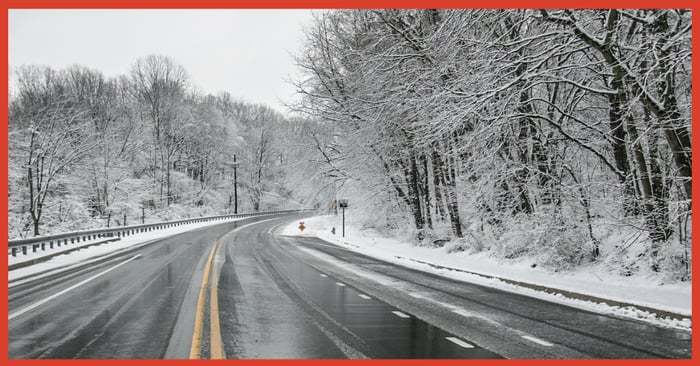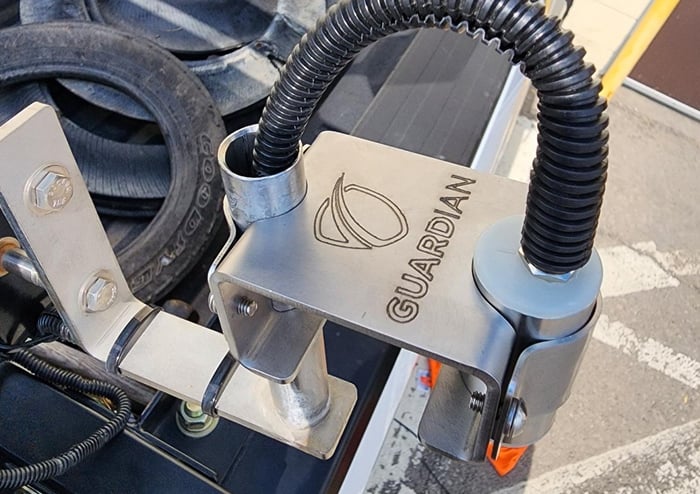
Table of Contents
What You Need to Know About Black Ice for Safe Winter Driving:
At DiCAN, we understand the importance of keeping your fleet safe, in all weather conditions. Part of keeping your fleet safe in the winter is understanding some of the perilous conditions that can arise. By understanding some key features of black ice, like how and when it is formed, and what to do if caught driving on it, you can help keep your fleet and drivers safe.
What is Black Ice?
Black ice is a thin coat of ice that forms on roads under very specific conditions. It gets its name from being so thin that it is highly transparent and it takes on the black colour of the road. It is nearly impossible to see. Hazardous driving conditions are created as drivers are easily caught off-guard by the slippery roadways created by black ice.
How & Why Does Black Ice Develop?
Black ice formation occurs when some specific conditions are met involving 4 key measurements:
- Air temperature
- Road surface temperature
- Relative humidity
- Dew point
To begin, when the air becomes saturated with water and can no longer hold all its moisture it is forced to condense onto surfaces like roads. The temperature at which this happens is referred to as the dew point. The dew point is affected by the air’s humidity. The more moisture the air can hold, the higher its dew point will be. A high dew point close to the air temperature will create a high relative humidity environment, encouraging condensation onto cold surfaces. When the road surface temperature is at or just below freezing this condensation turns to black ice. However, black ice can also form when the road surface temperature is slightly above freezing if the dewpoint is high and roads are cooling faster than the air.
Black ice is most common in the night and early morning hours when the lack of sunlight makes it even more difficult for drivers to identify. Black ice formation happens during these hours because the ground cools faster than the surrounding air, often leading to dew point condensation and freezing. Black ice also forms readily on bridges and overpasses because the road surface of these structures can be cooled from both the top and bottom, bringing about faster freezing.
What To Do If You Get Caught on Black Ice
If you are ever caught driving on black ice, you can protect yourself by knowing what to do. A general rule of thumb is to remain calm, do as little as possible and allow the vehicle to pass over the black ice. Do not hit the brakes and keep the steering wheel straight. If you feel the rear end of your vehicle sliding to the left or right, very gently turn the steering wheel in the same direction. Trying to correct by steering in the opposite direction could result in spinning. You can help your vehicle to slow by taking your foot completely off the gas. Using the brakes will likely cause you to skid. Most black ice is short and patchy so it is likely your vehicle will find traction again quickly. For an in-depth guide on what to do in all scenarios involving black ice check out this guide from the US Forest Service.
Is There a Way to Avoid Black Ice Altogether?
At DiCAN, we believe the best defense against black ice is taking a proactive approach. By knowing when the conditions for black ice formation are being met, timely and efficient de-icing measures can be taken. The DiCAN Guardian Plus is a system that allows you to assess and predict road conditions using sensors that monitor vital information including the air temperature, road surface temperature, relative humidity and dew point. By using DiCAN’s Guardian Plus system as a tool to inform municipalities and private snow contractors about environmental conditions conducive to black ice formation, they can manage resources and the application of de-icing agents effectively. The presence of black ice on our roadways can be minimized or even eliminated to reduce the number of accidents during the winter months & risk to all drivers.
Black ice formation along roadways is inevitable in the winter months. Understanding the science behind how ice forms on roads, as well as the weather factors that contribute to its formation, are essential for effective prevention and treatment. Believing in preventative safety solutions, DiCAN has created the Guardian Plus system to allow users to predict black ice formation and be able to respond appropriately before dangerous driving conditions are created. Preventing dangerous road conditions is the best way to ensure a safe and successful winter for your fleet and drivers.





